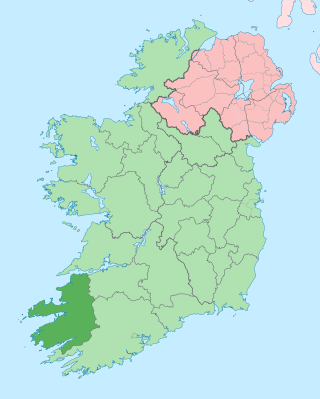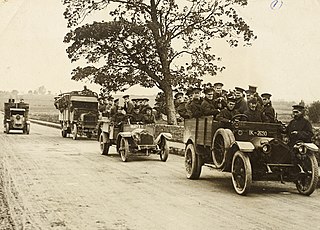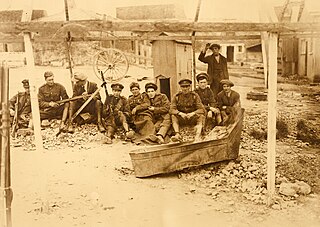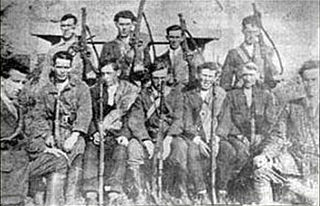
County Kerry is a county in Ireland. It is in the Southern Region and the province of Munster. It is named after the Ciarraige who lived in part of the present county. The population of the county was 156,458 at the 2022 census.

Thomas Bernardine Barry, better known as Tom Barry, was a prominent guerrilla leader in the Irish Republican Army (IRA) during the Irish War of Independence and the Irish Civil War. He is best remembered for orchestrating the Kilmichael ambush, in which he and his column wiped out a 18-man patrol of Auxiliaries, killing sixteen men.

This is a timeline of the Irish War of Independence of 1919–21. The Irish War of Independence was a guerrilla conflict and most of the fighting was conducted on a small scale by the standards of conventional warfare.

The Irish Free State offensive of July–September 1922 was the decisive military stroke of the Irish Civil War. It was carried out by the National Army of the newly created Irish Free State against anti-treaty strongholds in the south and southwest of Ireland.

The executions during the Irish Civil War took place during the guerrilla phase of the Irish Civil War. This phase of the war was bitter, and both sides, the government forces of the Irish Free State and the anti-Treaty Irish Republican Army (IRA) insurgents, used executions and terror in what developed into a cycle of atrocities. From November 1922, the Free State government embarked on a policy of executing Republican prisoners in order to bring the war to an end. Many of those killed had previously been allies, and in some cases close friends, of those who ordered their deaths in the civil war. In addition, government troops summarily executed prisoners in the field on several occasions. The executions of prisoners left a lasting legacy of bitterness in Irish politics.
Thomas McEllistrim was an Irish Fianna Fáil politician who served as a Teachta Dála (TD) from 1923 to 1969. He was a military activist in the period from 1916 to 1923.

John O'Connor, known politically as Johnny Connor, was an Irish Clann na Poblachta politician who served as a Teachta Dála (TD) for the Kerry North constituency from 1954 to 1955.
Stephen Fuller was an Irish Fianna Fáil politician who served as a Teachta Dála (TD) for the Kerry North constituency from 1937 to 1943.
The Kerry Senior Hurling Championship is an annual hurling competition organised by the Kerry County Board of the Gaelic Athletic Association since 1889 for the top hurling teams in the county of Kerry in Ireland.
This is a timeline of the Irish Civil War, which took place between June 1922 and May 1923. It followed the Irish War of Independence (1919–1921), and accompanied the establishment of the Irish Free State as an entity independent from the United Kingdom of Great Britain and Ireland.

The Headford Ambush was carried out by the Irish Republican Army (IRA) on 21 March 1921, during the Irish War of Independence. The IRA's 2nd Kerry Brigade ambushed a train carrying British troops of the Royal Fusiliers at Headford Junction railway station near Killarney, County Kerry. This sparked a battle lasting almost an hour, in which at least 13 people were killed – eight British soldiers, two IRA volunteers and three civilians. The IRA withdrew after another train carrying British troops arrived.
John Joseph Sheehy was an Irish political/military activist and sportsperson. He participated in the Irish War of Independence and Irish Civil War in the Irish Republican Army (IRA), where he was a senior figure in County Kerry. He also gained fame as a successful Gaelic footballer representing the Kerry county team.

The guerrilla phase of the Irish Civil War began in August 1922, when the forces of the Irish Free State took all the fixed positions previously held by the Anti-Treaty IRA. The IRA then waged a guerrilla war to try to bring down the new Irish Government and overturn the Anglo-Irish Treaty. This guerrilla campaign was ultimately defeated.

The National Army, sometimes unofficially referred to as the Free State army or the Regulars, was the army of the Irish Free State from January 1922 until October 1924. Its role in this period was defined by its service in the Irish Civil War, in defence of the institutions established by the Anglo-Irish Treaty. Michael Collins was the army's first commander-in-chief until his death in August 1922.

George O'Shea was an Irish Republican Army (IRA) soldier who fought with the Anti-Treaty side during the Irish Civil War. He was one of eight men killed by Free State forces in the Ballyseedy Massacre, a defining event in Irish history.

Timothy Lyons, a.k.a. Aero or Aeroplane, was an Irish Republican Army (IRA) soldier who fought with the Anti-Treaty side during the Irish Civil War. After a three-day siege by Free State forces at Clashmealcon, County Kerry, he died after falling from a cliff onto rocks and then being shot.
Reginald Walter Stenning was a British Army deserter who joined the Irish Republican Army (IRA), fighting on the anti-Treaty side in the Civil War. After being captured by Free State forces he was beaten and executed.
James McEnery was a farmer and IRA soldier who fought on the anti-Treaty side in the Irish Civil War in north Kerry. He surrendered during a three-day siege by Free State forces, in the last significant action of the War, and was executed seven days later.
Edmond Greaney [also 'Edward', 'Eamonn/Eamon' and 'Greany' on historical documents] was a farm labourer and IRA soldier who fought on the anti-Treaty side in the Irish Civil War in north Kerry. He was captured by Free State forces and executed after the last major action of the War.
Thomas McGrath was an IRA soldier who fought on the anti-Treaty side in the Irish Civil War in north Kerry. He drowned after trying to escape a siege by Irish Free State forces at Clashmealcon during what was the last major military action of the War.










